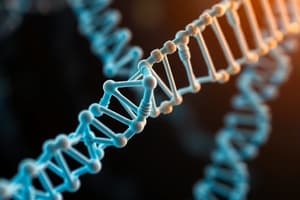Podcast
Questions and Answers
What is the primary function of ribosomes?
What is the primary function of ribosomes?
- Energy production
- DNA replication
- Protein synthesis (correct)
- Transport of substances
The nucleolus is responsible for producing ribosomes.
The nucleolus is responsible for producing ribosomes.
True (A)
What are the two types of nucleic acids found in living organisms?
What are the two types of nucleic acids found in living organisms?
DNA and RNA
The jelly-like fluid within the nucleus is called the ______.
The jelly-like fluid within the nucleus is called the ______.
Match the following parts of the nucleus with their functions:
Match the following parts of the nucleus with their functions:
What is the primary substance that allows metabolic reactions to occur in cells?
What is the primary substance that allows metabolic reactions to occur in cells?
Chromatin network is found inside the nucleolus.
Chromatin network is found inside the nucleolus.
The _____ is a dark body within the nucleoplasm that produces ribosomes.
The _____ is a dark body within the nucleoplasm that produces ribosomes.
Match the following parts of the nucleus with their descriptions:
Match the following parts of the nucleus with their descriptions:
Which of the following organelles is primarily involved in protein synthesis?
Which of the following organelles is primarily involved in protein synthesis?
DNA is contained within the cytoplasm of the cell.
DNA is contained within the cytoplasm of the cell.
What is the function of the double nuclear membrane?
What is the function of the double nuclear membrane?
Ribosomes are composed of _____ and protein.
Ribosomes are composed of _____ and protein.
What do chromosomes contain?
What do chromosomes contain?
Flashcards
DNA (Deoxyribonucleic Acid)
DNA (Deoxyribonucleic Acid)
A type of nucleic acid responsible for storing and transmitting genetic information.
RNA (Ribonucleic Acid)
RNA (Ribonucleic Acid)
A type of nucleic acid that plays a crucial role in protein synthesis, acting as a messenger carrying genetic information from DNA to ribosomes.
Protein Synthesis
Protein Synthesis
The process by which cells create proteins based on the genetic instructions encoded in DNA.
Cytoplasm
Cytoplasm
Signup and view all the flashcards
Ribosomes
Ribosomes
Signup and view all the flashcards
What is cytoplasm?
What is cytoplasm?
Signup and view all the flashcards
What is a ribosome and what does it do?
What is a ribosome and what does it do?
Signup and view all the flashcards
What is the nuclear membrane?
What is the nuclear membrane?
Signup and view all the flashcards
Describe nucleoplasm.
Describe nucleoplasm.
Signup and view all the flashcards
What is the nucleolus and what does it do?
What is the nucleolus and what does it do?
Signup and view all the flashcards
What is the chromatin network?
What is the chromatin network?
Signup and view all the flashcards
What is protein synthesis?
What is protein synthesis?
Signup and view all the flashcards
What is RNA?
What is RNA?
Signup and view all the flashcards
What is DNA?
What is DNA?
Signup and view all the flashcards
What is the difference between DNA and RNA?
What is the difference between DNA and RNA?
Signup and view all the flashcards
Study Notes
DNA and RNA
- All living organisms contain both DNA (deoxyribonucleic acid) and RNA (ribonucleic acid)
- Focus on location, structure, and function of DNA and RNA
Protein Synthesis
- Protein synthesis is vital for life
- Proteins are formed by both DNA and RNA
Cellular Structure
- Cytoplasm: The base substance in cells where organelles are suspended; allows metabolic reactions
- Ribosomes: Small, round organelles, often attached to the endoplasmic reticulum or free-floating; sites of protein synthesis; found inside other organelles like chloroplasts and mitochondria, consisting of RNA and protein
- Nucleus: Controls all cellular activities
- Nuclear membrane: Encloses the nucleus with pores for substance passage
- Nucleoplasm: Jelly-like fluid within the nucleus
- Nucleolus: Dark body within the nucleoplasm; produces ribosomes
- Chromatin network: Found in nucleoplasm; DNA forming chromosomes containing the genetic code of an organism
Studying That Suits You
Use AI to generate personalized quizzes and flashcards to suit your learning preferences.
Related Documents
Description
Explore the fundamental concepts of DNA and RNA, including their structures and functions in the cell. Understand the critical process of protein synthesis and the roles of various cellular components such as ribosomes and the nucleus. This quiz will solidify your knowledge of molecular biology.




